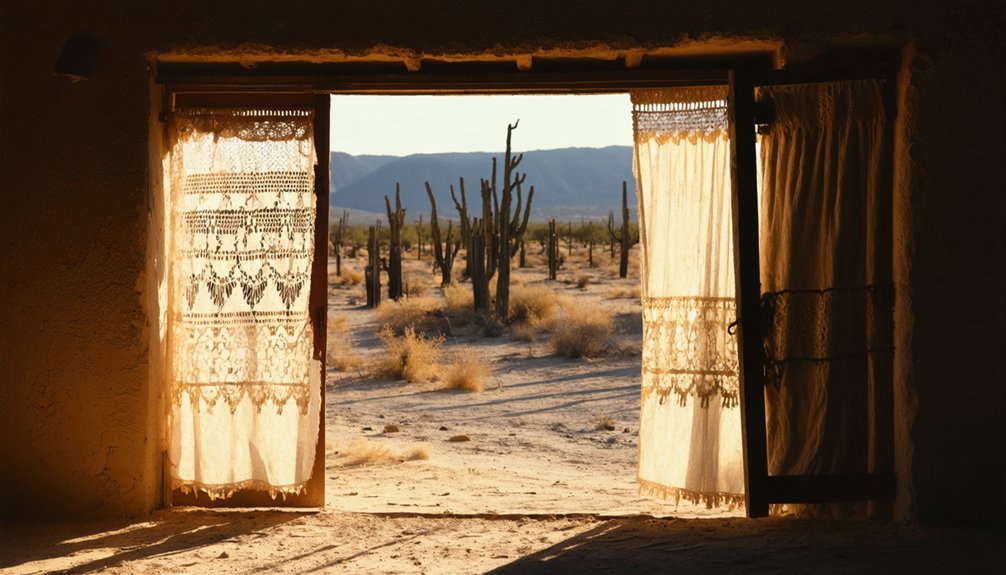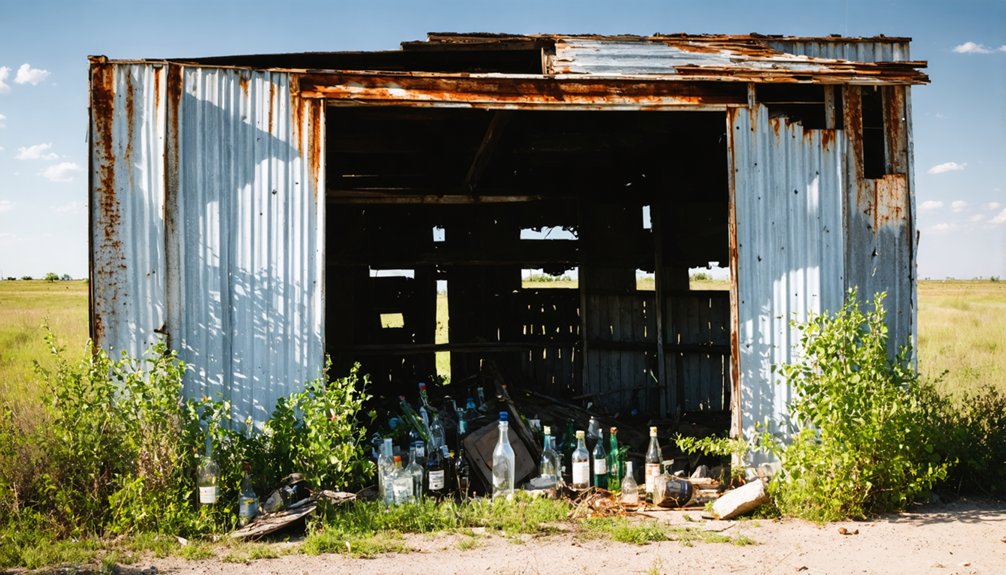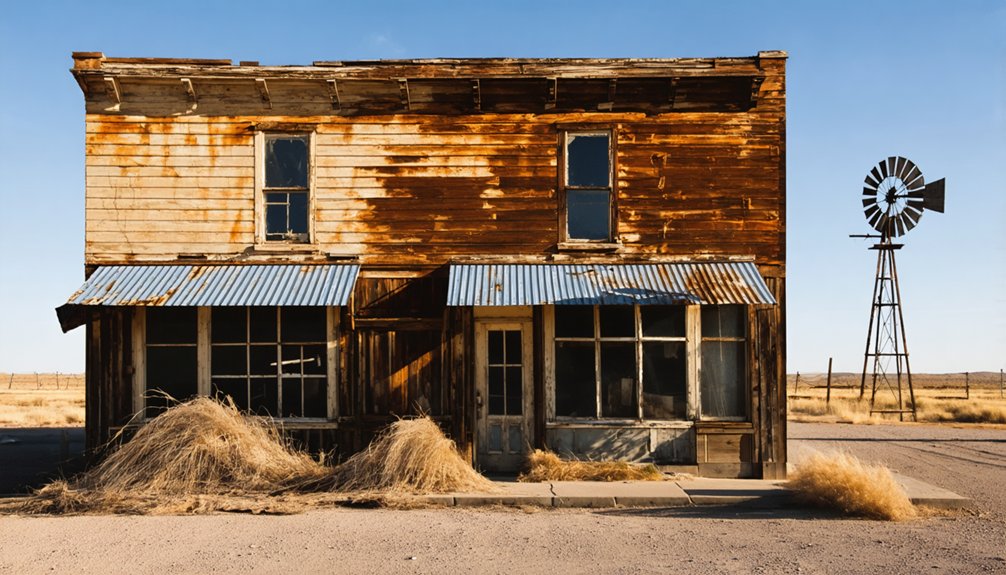You’ll find White Way tucked away in Hamilton County, Texas at 1,014 feet above sea level. This former stop between Jonesboro and Hamilton peaked at 14 residents before declining to just a handful by 1966. Today, scattered stone foundations, rock motel ruins, and a historic cemetery tell the tale of this pioneer settlement. The site’s weathered remnants and untapped archaeological wealth hold countless secrets of Texas frontier life waiting to be discovered.
Key Takeaways
- White Way was a small Texas settlement between Jonesboro and Hamilton, originally known as Whitesboro, built around White family businesses.
- The town peaked at 14 residents and declined to just 4 by 1966, eventually reaching about 10 residents by 2000.
- Located in Hamilton County at 31°38′35″N, 97°58′18″W, the ghost town sits 1,014 feet above sea level among rolling hills.
- Historical remnants include stone foundations, rock motel ruins, and a cemetery, though many structures have deteriorated over time.
- Economic factors, including rural-to-urban migration and shifting transportation routes, led to White Way’s eventual abandonment and ghost town status.
Origins in Beer Legislation
While many Texas towns sprouted up around railroads or cattle trails, White Way’s origins traced back to the state’s complex history of alcohol regulation.
You’ll find its story rooted in Texas’s unique local option system, which created a patchwork of wet and dry counties across the Lone Star State from 1876 onward.
When national Prohibition hit in 1920, the landscape of beer production shifted dramatically, forcing adaptations that would shape communities like White Way.
The 1930s brought sweeping legislative impact as Texas first allowed 3.2% beer in 1933, then fully repealed state prohibition by 1935.
Texas made its gradual return to legal beer, starting with 3.2% brews in 1933 before fully ending prohibition two years later.
The Texas Liquor Control Act of 1936 ushered in new possibilities for beer production and distribution, setting the stage for White Way’s brief but notable chapter in Texas brewing history.
Before Prohibition, Texas had 10 wet, 43 partly wet, and 201 dry counties shaping the state’s complex alcohol geography.
By 1908, the prohibition movement had gained significant momentum, resulting in 152 dry counties across Texas.
Life in 1930s Gaines County
Three major forces shaped life in 1930s Gaines County: the punishing Dust Bowl, the Great Depression‘s economic strain, and the promising emergence of oil production.
You’d have seen massive sand dunes, 20-30 feet high, swallowing once-productive farmland. Nearly half of the county’s farmers lost their land between 1929 and 1935, forcing many into economic migration.
Yet even as agriculture suffered, with cotton production plummeting and cropland shrinking, oil discoveries brought new hope. By 1935, the Seminole Pool’s discovery transformed the local economy. The oil was found at depths of 5,000 to 6,000 feet. The area’s first settlers were Comanche and Comancheros who had inhabited these lands long before the county’s establishment.
You’d have witnessed Seminole and Seagraves growing as commercial hubs, while the railroad kept communities connected. Despite harsh environmental challenges, the county’s population actually grew to 8,136 by 1940, thanks largely to the booming oil industry.
The Rise and Fall
Like many small Texas settlements, White Way emerged from humble beginnings as a stopping point between Jonesboro and Hamilton.
Originally known as Whitesboro, this plucky community was built around the enterprising White family, who established essential businesses to serve travelers and locals alike. Other Texas towns like Springfield saw similar modest starts but grew to become the largest city between Dallas and Houston by 1850. Similar to how German immigrants entered Texas through bustling port cities, White Way served as a vital waypoint for inland travelers.
The community dynamics centered on a modest but crucial collection of services – a church, cemetery, gas station, garage, body shop, and grocery store.
Small towns thrive on simple but vital services – places to worship, rest, refuel, repair, and restock daily necessities.
You’d have found about 14 residents during its peak years, all contributing to the town’s identity.
But economic shifts gradually took their toll. By 1966, the population had dwindled to just four souls, and while the town managed to maintain around 10 residents by 2000, it stands today as a reflection of the changing tides of rural Texas life.
Location and Geography
Nestled in the heart of Hamilton County at 31°38′35″N latitude and 97°58′18″W longitude, White Way stands as a tribute to Texas’ rural heritage.
You’ll find this unincorporated community perched at 1,014 feet above sea level, where the rolling hills of southeastern Hamilton County stretch toward the horizon.
The geographical features around White Way showcase the untamed spirit of central Texas, with scattered woodlands and open farmland dominating the landscape. Like many Farm-to-Market Roads throughout Texas, the routes leading to White Way remain well-maintained and accessible.
The community layout reflects its historical role as a waypoint between Jonesboro and Hamilton, with a church and cemetery marking its presence.
You’ll spot the remnants of what was once a thriving rural stop, complete with a gas station and garage that served countless travelers along these country roads.
For clarity in historical records, White Way requires proper disambiguation of place names to distinguish it from similarly named locations across Texas.
Historical Significance
Standing as a symbol of Texas’ pioneering spirit, White Way emerged during the late 19th century when railroad expansion and agricultural development transformed the central Texas landscape.
Like many of its ghost town counterparts, you’ll find its historical landmarks shaped by the railroad’s influence and the determined settlers who built their lives around it. The town’s cultural impact reflects the diverse mix of immigrant laborers who came seeking opportunity in mining and agriculture. Similar to Medicine Mound, the town attracted early settlers due to low land prices. The community used a system where workers were paid with company scrip for purchases at local stores.
Settlers and immigrants transformed White Way into a vibrant hub, drawn by the promise of mining, farming, and railroad opportunities.
While few physical remnants remain, White Way represents a significant chapter in Texas history when small communities dotted the landscape, serving as essential hubs for commerce and community life.
The town’s story mirrors the broader tale of boom-and-bust cycles that defined many Texas settlements during this transformative era.
Town Demographics
You’ll find White Way’s population followed a pattern common to many small Texas settlements, reaching its zenith at 14 residents before dropping to just 4 by 1966.
The town’s last documented count showed 10 souls in 2000, though it has likely dwindled further as rural flight continues to reshape Texas’s countryside.
Like many of its sister communities across the Lone Star State, White Way reflects the demographic shifts that have transformed once-thriving rural hamlets into near-ghost towns.
Population Rise and Decline
Like many Texas railroad towns of the early twentieth century, White Way experienced dramatic shifts in population that mirrored the rise and fall of rural communities across the state.
The town’s population dynamics were closely tied to local agriculture and transportation developments, with initial growth sparked by nearby railroad activity and trade routes.
You’ll find that economic factors played a significant role in White Way’s eventual decline, following patterns similar to other Texas ghost towns.
As younger residents sought opportunities in urban areas, the aging population dwindled. The rise of automobiles and new highways shifted focus away from rail-dependent communities, while the loss of local businesses and services accelerated the town’s depopulation.
Local Resident Characteristics
The demographics of White Way tell a stark tale of rural Texas decline, with the town’s population dwindling to around 10 residents by 2000.
While specific data remains limited due to the town’s tiny size, you’ll find a community that mirrors other rural Texas towns in the region, where aging residents, often widowed, make up a significant portion of the population.
Local culture has shifted dramatically from White Way’s heyday when the school and businesses created natural gathering spots for community events.
The few remaining residents represent an echo of the town’s past prosperity, with most being older adults.
Like many ghost towns across Texas, White Way’s working-age population has largely moved away, seeking opportunities elsewhere, leaving behind a quiet reminder of what was once a vibrant rural community.
Remnants and Remains

Today you’ll find only scattered stone foundations and rock motel ruins marking White Way’s former presence along the old rail line.
The town’s cemetery grounds remain one of the few identifiable features from the original settlement that peaked at 150 residents in the 1920s and ’30s.
These modest remnants, though lacking intact buildings, offer archaeologists valuable insights into early 20th-century Texas railroad communities and their transient lodging practices.
Physical Structures Today
Despite years of abandonment, White Way’s remaining structures stand as weathered sentinels of Texas frontier life, with several stone foundations and deteriorating wooden buildings still marking the townsite’s footprint.
You’ll find structural decay everywhere you look, but these building remains tell the story of our pioneer ancestors who carved out their lives in the Texas wilderness.
When exploring White Way today, you’ll discover:
- Original stone foundations peeking through wild grass and mesquite
- Partially standing wooden structures with collapsed roofs that once housed determined frontier families
- Weathered chimneys and stacked rock walls that hint at the town’s former bustling streets
These silent ruins remind us of the grit and determination that built Texas, preserving a tangible connection to our independent spirit and pioneering heritage.
Preservation State Assessment
As time marches relentlessly across the Texas Panhandle, White Way’s historical remnants face mounting preservation challenges from both natural forces and human interference.
The harsh Texas weather batters exposed foundations while vegetation slowly reclaims the site. You’ll find the archaeological significance diminished by unauthorized artifact removal and vandalism, though stone foundations prove more resilient than their wooden counterparts.
Without formal protection or regular maintenance, these precious fragments of Texas history remain vulnerable. Wind and rain erode the soil, occasionally revealing buried treasures, while wildlife burrows through the layers of time.
Local history enthusiasts make valiant efforts to document and stabilize what remains, but without organized preservation efforts, White Way’s physical legacy continues to fade into the windswept prairie.
Archaeological Site Potential
The untapped archaeological wealth of White Way lies scattered across several acres of wind-swept Texas prairie.
You’ll find a treasure trove of archaeological significance in the weathered ruins and buried remains, each telling a story of Texas frontier life. The site’s potential for artifact recovery draws researchers hoping to understand our independent spirit through physical remnants.
Here’s what makes White Way an archaeological goldmine:
- Building foundations and structural remains reveal the town’s layout, including possible mercantiles, residences, and mining operations.
- Domestic artifacts like ceramics, bottles, and personal items paint a picture of daily frontier life.
- Subsurface deposits preserve multiple layers of history, from early settlement through the town’s eventual abandonment.
These remnants hold the key to understanding how our Texas ancestors carved out their existence on the untamed frontier.
Legacy in Texas History

While many Texas ghost towns left indelible marks on the state’s history, White Way’s legacy speaks through its quieter contribution to rural Texas life in the early 20th century.
You’ll find its story woven into the broader tapestry of economic changes that transformed Texas from an agricultural society to an urbanized state. The town’s decline mirrors the cultural shifts that swept through rural communities as families moved toward larger cities after World War II.
Though White Way’s physical remains are scarce, its memory lives on through oral histories passed down by descendants in neighboring towns.
Echoes of White Way endure in the stories told by local families, preserving memories of a once-vibrant Texas community.
You’re witnessing a piece of Texas history that represents countless small communities that once dotted the landscape, each playing its part in shaping the state’s rural heritage and community spirit.
Preservation Efforts
Preserving White Way’s remaining structures and historical legacy has become a focal point for dedicated local preservation groups and statewide organizations.
You’ll find that Preservation Texas has stepped in to champion White Way’s architectural heritage through strategic community involvement and preservation funding initiatives. Local preservation groups now offer guided access to historically significant sites, protecting these treasures while sharing their stories.
Key preservation milestones include:
- Establishment of a local museum housing family-donated artifacts
- Annual reunions organized by nonprofit boards to maintain connections with descendants
- Implementation of controlled access programs to safeguard fragile structures
Through these efforts, you’re witnessing the careful balance of protecting White Way’s past while ensuring its story endures for future generations of Texans to discover and appreciate.
Frequently Asked Questions
Why Was the Town Specifically Named “White City”?
You’ll find the town naming traced to its lumber industry roots, where fresh-cut “white” wood and the railway station’s clean, pioneering image shaped its historical significance as a frontier settlement.
Were There Any Notable Crimes or Lawlessness During White City’s Existence?
Like a blank page in Texas history, you won’t find any notable crimes or lawlessness in White City’s story. Historical records show no significant crime history or law enforcement issues during its existence.
What Happened to the Original Residents After the Town’s Abandonment?
You’ll find most residents’ relocation led them to nearby Texas towns like Wichita Falls and Henrietta, seeking jobs and better lives, while their stories live on through descendant families today.
Did White City Have a School, Church, or Other Community Buildings?
You bet your boots they did! Whiteway packed education facilities including a school in 1936, plus a church with cemetery for community gatherings. The White family ran local businesses like shops and garages.
What Were the Primary Occupations of White City’s Inhabitants?
You’d find folks working the land through agricultural practices, running local businesses like the White family’s garage and store, teaching at the schoolhouse, and serving travelers passing between towns.
References
- http://texasghosttowns.blogspot.com/2011/10/
- https://www.youtube.com/watch?v=phjUE19A8HM
- https://en.wikipedia.org/wiki/List_of_ghost_towns_in_Texas
- https://mix931fm.com/texas-ghost-towns-history/
- https://www.tshaonline.org/handbook/entries/white-city-tx-gaines-county
- https://www.texasescapes.com/CentralTexasTownsNorth/White-Hall-Texas.htm
- https://www.tshaonline.org/handbook/entries/whiteway-tx
- https://www.texasescapes.com/TOWNS/Texas_ghost_towns.htm
- https://texascraftbrewersguild.org/legislative-history/
- https://www.uiw.edu/sanantonio/seymour.html



